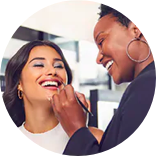Thanks for the tag, @itsfi !
And sorry I’m so late to this, @ajabanda ! Based on what you’ve said so far, here are my suggestions. Note that none of this is an overnight miracle: skincare results take time, patience, and consistent use. Oh, and when starting new products, be sure to introduce them to your skin one at a time: use one for 1-3 weeks, see how your skin tolerates it, and then introduce another product. That way, your skin’s less likely to throw a “what the heck is THIS” tantrum—and if it does, you can more easily narrow down the culprit.
The “one and done” product to treat everything: that would be vitamin A, which is the retinoid family. You could try pretty much any OTC retinol product. Or consider retinaldehyde (aka retinal—note the “a” instead of “o”) which is more powerful (works faster) than retinol and less irritating than tretinoin, the OG prescription retinoid. There’s also adapalene which is great for acne. Whichever you choose, start with a low strength product and use it just once or twice a week (never twice on the same day) for a few weeks. Then increase usage to 2-3 times a week for a few weeks. Keep gradually increasing usage til you’re at a comfy-for-you frequency; could be nightly, every other night, or even just 3 nights a week.
As powerful as vitamin A is, it does play nice with a few other ingredients, including the ones I’m about to mention. And even if you choose to try just a retinoid (no BHA, azelaic acid, etc.), you should still also use the last item (sunscreen) on my list below.
Acne: as @makeitup305 said, salicylic acid (a BHA) may help. Note that there are different types of acne and they don’t all respond to the same ingredients. (Deep cystic acne, for instance, is best treated with a dermatologist’s help and may need a prescription treatment or something OTC like adapalene or benzoyl peroxide. A derm can also do cortisone injections to quickly reduce deep cysts.) But in general, BHA’s a good starting point, especially for blackheads.
If you need a lower cost option than the fantastic Paula's Choice Mini Skin Perfecting 2% BHA Liquid Exfoliant, consider The INKEY List Beta Hydroxy Acid (BHA) Blemish + Blackhead Serum 1 oz/ 30 mL , or just visit your local drugstore or Target for more options. Doesn’t really matter if the product’s called an “exfoliant” vs. “toner” vs. “serum”: in any of those product types, BHA will get down into your pores to degunk ‘em and do some exfoliation. You want something that contains 2% “salicylic acid,” not “willow bark extract” which is in the same family but doesn’t do everything salicylic acid can. If you find your skin doesn’t tolerate a leave-on BHA product, consider swapping your usual cleanser twice a week for one that contains 2% BHA like CeraVe Acne Control Cleanser or The INKEY List Salicylic Acid Acne + Blackhead Cleanser.
A clay mask once or twice a week might also help loosen your blackhead plugs. A good option that also contains BHA is The Ordinary Salicylic Acid 2% Masque . Also consider The INKEY List Kaolin Mask 1.7 oz/ 50 mL or Origins Mini Clear Improvement™ Active Charcoal Mask to Clear Pore 1 oz/ 30 mL (the only Origins skincare product my skin will tolerate).
PIH (acne scars): azelaic acid can help here. It treats hyperpigmentation, especially post-inflammatory hyperpigmentation (PIH, such as dark marks left by acne). It also targets acne-causing bacteria, acts as an antioxidant, soothes inflammation, and does some mild exfoliation. And azelaic acid plays nice with pretty much any other ingredient—in fact, it’s a good partner for BHA and other things that address hyperpigmentation. @jaaayp already mentioned my favorite product, Paula's Choice 10% Azelaic Acid Booster for Redness Relief 1 oz/ 30 mL which also contains 0.5% BHA. Also consider Peach Slices Redness Relief Azelaic Acid Serum, available at Ulta, or The Ordinary Azelaic Acid 10% Suspension Brightening Cream, or even The INKEY List SuperSolutions 10% Azelaic Serum Redness Relief Solution 1 oz / 30 mL.
Texture: BHA and azelaic acid will help, but this is where niacinamide really comes in clutch. Niacinamide does many good things for skin, such as reducing texture and balancing skin tone. You’ve used some niacinamide products before. You could bring one of those back into your routine, if you still have ‘em laying around and they haven’t expired. Or consider a standalone niacinamide product like Paula's Choice 10% Niacinamide Booster 0.67 oz/ 20 mL , The INKEY List Niacinamide Oil Control Serum 1 oz/ 30 mL , or COSRX The Niacinamide 15 Serum.
An AHA (alpha hydroxy acids like glycolic, lactic, mandelic) or PHA (poly hydroxy acid, which is milder than AHA) can also reduce texture (and help with PIH). But I recommend not using one of those until your skin’s gotten used to other new products you introduce to your routine. And when/if you do start using an AHA or PHA, use it just 1-3 times a week so you don’t break your skin barrier and leave your face wide open to more acne-causing bacteria and other badness.
Broad spectrum sunscreen (at least SPF 30): do you already use one? We should all generously apply sunscreen to all skin exposed to sunlight (eyelids, hairline, ears, behind ears, nape of neck if exposed, etc.) all year long, regardless of weather or season. UV rays can worsen acne, and there’s no point trying to reduce dark acne marks if you don’t also stop the sun from causing more hyperpigmentation. Which one’s right for you depends a lot on your personal preferences. I have mostly-dry combo skin and one of my tried and trues is Supergoop! Unseen Sunscreen Invisible Broad Spectrum SPF 40 PA +++, but I also use several others and rotate through them on a regular basis.














